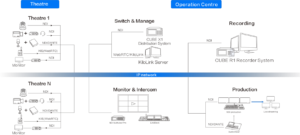The development of wireless technology in recent years has made it possible to wirelessly transmit at a rate of 100 Mbps from 30 to 100 feet or more. High-definition TV, computer monitors and projectors for high-speed wireless high-definition audio and video image transmission not only give people visual enjoyment, but also provide a lot of convenience for our work and life, and greatly improve work efficiency; however, The large amount of uncompressed high-definition video images brings a lot of pressure to the transmission channel, and in terms of current domestic bandwidth, it is impossible to meet the conditions for transmitting high-definition video data. In order to solve the problem of large amount of digital video data, it is necessary to compress the data.
H.264 video compression standard is the best choice
Although several video compression standards are now available to reduce the bit rate of video signals to within reasonable limits, the latest H.264 standard is clearly the best choice. To cover a wide range of application scenarios, H.264 defines a combination of grades, levels, and coding tools. For example, by adjusting the quantization parameters, a reconstructed video that is comparable to the original input can be generated. In the encoding process, only I frames can be used, or P frames or B frames can be used to improve coding efficiency by reducing redundancy in the time domain. H.264 can compress YUV input in 4:2:2 or 4:4:4 format, as well as 24-bit/pixel and above formats, and it even includes a lossless grade. The efficient H.264 encoder can reduce the bit rate of 1080p60 HD video to around 50Mbps, with a compression ratio of 75:1 compared to the 3.6Gbps code rate before compression. More importantly, H.264 has been widely used in the industry. Digital cameras and digital cameras have also begun to adopt H.264 HD encoders, and their prices are quite low.
Delay – the huge challenge of video compression
The key challenge in wireless HD video transmission is how to reduce the latency caused by computing. When the resolution, frame rate, and color depth of the video are increased, the delay is further increased. This is a problem that all video coding standards will face, and H.264 is also inevitable. In addition, rate control also introduces an increase in latency. This is because the buffer used to smooth the output bit rate results in a larger delay. Generally, the smaller the code rate fluctuation is, the better it is to avoid the bandwidth fluctuation and affect the quality of the video at the decoder end. I frames always cause large fluctuations in the code rate. Even between two I frames, the code rate may vary considerably as the complexity of the image changes. Other factors such as pre-processing will also increase the delay.
Although the encoder produced by some manufacturers are also high-definition, the delay is as high as 200ms or even 500ms, which makes the video of the terminal unable to have real-time effects. As a professional HD video encoder manufacturer in the industry, Changsha Kiloview concentrates the advantages of the previous video compression standard H.264 video compression algorithm, and absorbs the accumulated experience in standard development. It independently supports 1080P/60 frames. The high-definition audio and video encoder adopts a dedicated video processing chip, which greatly improves the compression of the video encoder through innovations in architecture and algorithms while ensuring that the quality of the HD video is not affected, but also reduces the video bit rate. The ratio makes the video end-to-end transmission delay less than or equal to 2 frames (such as less than 35ms at 60fps), which alleviates the bottleneck in video processing and rate control.
High compression ratio advantage significantly solves the problem
For wireless HD video transmission systems, Changsha Kiloview’s wireless HD video encoder has another significant advantage – high compression ratio. The encoder supports 300K ~ 40Mbps dynamic code stream coding; transmission code rate, video coding parameters can be adjusted according to actual needs. The products can be widely used in the fields of drone, emergency communication, vehicle monitoring, live broadcast, live broadcast, medical teaching and other real-time requirements. At the same time, it is also suitable for real-time system control, industrial automation, real-time data acquisition, military. Systems such as high-speed computing, intelligent transportation, aerospace, medical equipment, water conservancy and other modular and high-reliability, long-term application areas, video communication transmission applications in a variety of wired and wireless network environments.










